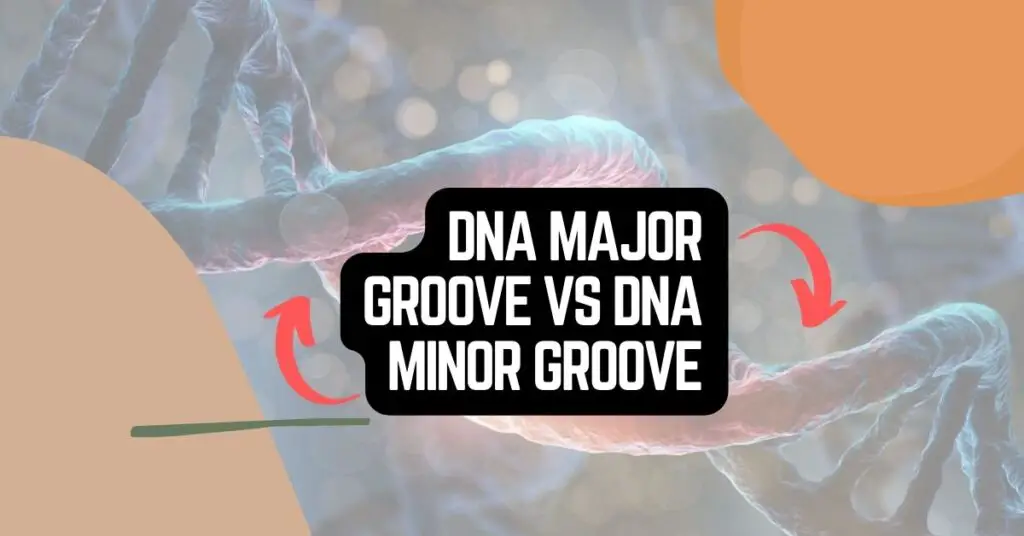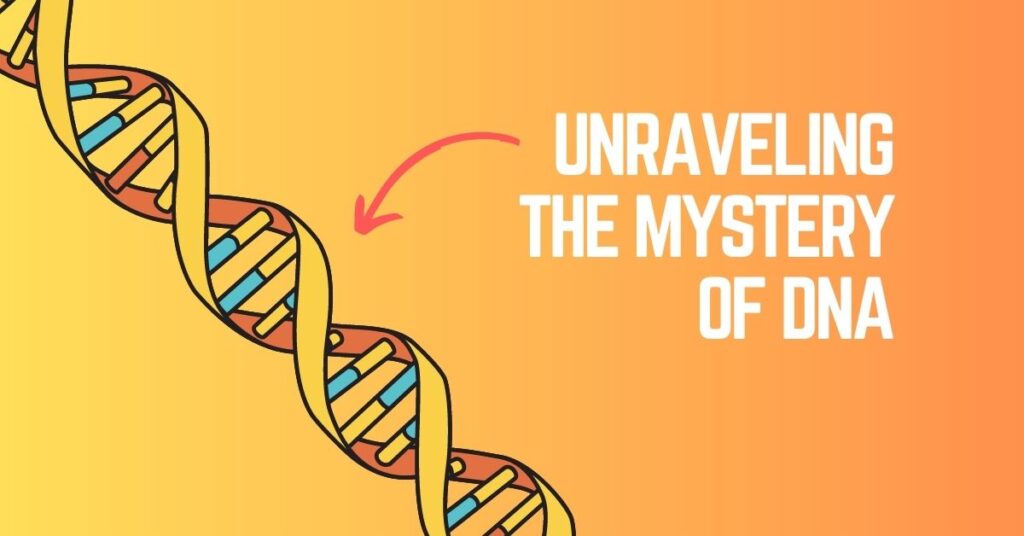“DNA major and minor grooves play a crucial role in biological processes and regulate gene expression. In this article, we will compare and contrast DNA major and minor grooves and understand their shape, size and importance.”
DNA is an essential molecule for life. It expresses, stores and transfers genetic information from one to the next generation and hence has crucial significance. The genetic information carried by DNA is necessary for development, reproduction and survival.
DNA is made up of sugar, phosphate and nitrogenous bases where the bases remain bound interiorly and the phosphate forms the outside backbone of DNA. The spiral, helical and double-stranded DNA structure is well-established and studied extensively.
The ‘distinct’ uneven positioning and base pairing gives DNA a classic helical structure and forms grooves. The major and minor grooves are two types of grooves present in DNA. Both have crucial importance in DNA-protein interaction, binding of different molecules and controlling gene expression.
However, the major groove takes more responsibility to attract many larger proteins and execute various functions. Therefore, it’s crucial to study and learn the importance of each. In this article, I will explain to you the structure, function and significance of major and minor grooves of DNA.
We will compare and contrast both and understand their size and functional differences. The present article will strengthen your DNA structural knowledge and give you more excess to understand the extensive structural properties and their importance.
Stay tuned.

Key Topics:
DNA major vs minor grooves- similarities:
Now let’s first initiate our article with some common similarities between both.
- Both grooves are the structural properties of the DNA and are formed by uneven intrinsic base pairing.
- The helical twisting of DNA provides the structure, depth and width to both grooves.
- Both grooves attract proteins and execute many functions. The protein-DNA interaction at each groove collectively offers replication, transcription, translation and other post-translational modification and helps in gene expression.
- Both grooves give the excess to various proteins to interact with the base pairs. For example, histones, transcription factors, translation and replication proteins.
However, despite their similarities, both major and minor DNA grooves are significantly different in terms of depth, width and shape. These structural differences give them unique properties to allow specific types of proteins.
DNA major vs minor groove- differences:
A DNA major groove is large in size and thus is wider and deeper than the minor groove. Minor groove is smaller in size.
The width of the major groove is ~22 to 26Å while the width of the minor groove is ~12 to15Å. In addition, the depth of the major groove is ~11Å conversely, the depth of the minor groove is ~6Å.
Although, these figures may be slightly different depending on the type of DNA. Take a look at the size of the major and minor grooves of A, B and Z form DNA.
| A form DNA: | DNA major groove | DNA minor groove |
| Size | 14 to 15Å | 7 to 8Å |
| Width | 6 to 8Å | 10 to 12Å |
| Depth | 4 to 5Å | 2 to 3Å |
| B form DNA: | DNA major groove | DNA minor groove |
| Size | 22 to 26Å | 12 to 15Å |
| Width | 12 to 14Å | 5 to 6Å |
| depth | 11Å | 6 to 7Å |
| Z form DNA: | DNA major groove | DNA minor groove |
| Size | 9 to 10Å | 3 to 4Å |
| Width | 4 to 5Å | 13 to 14Å |
| depth | 7 to 8Å | 1 to 2Å |
Keep in mind that these values are approximate and taken from peer-reviewed resources. The size can vary based on the types of DNA, a specific sequence and the conformation of the DNA. In addition, the protein bound to the groove can also impact the size, width and depth of each groove.
The above data suggest that the major groove of the B-form DNA (which is the most abundant form of the DNA on Earth) is wider, deeper and larger in size compared to the minor groove.
This postulate clearly that the major groove is more accessible to various proteins and can perform more lucrative functions for DNA.
However, before going ahead in the article, it’s important to note that, even though the major groove is larger in size than the minor groove; it is more complex and has distinct features whereas the minor groove is uniform in shape and relatively narrow and simple.
Furthermore, the major groove covers 10 to 12 bases per helix turn while the minor groove covers 5 to 6 bases per helix turn.
The major groove is a typical site for DNA-protein interaction and can allow even the larger proteins for ‘specific’ binding with DNA bases. While the minor groove is less commonly involved in such types of interactions. It is more restrictive and less specific.
Despite this, major and major grooves both have a specific binding capacity for various proteins and collectively perform replication, transcription, translation and DNA repair activities, etc.
The family of proteins that can bind to major and minor grooves is listed here in the table.
| DNA major groove binding proteins | DNA minor groove-binding proteins |
| Transcriptional factors | Helix-turn-helix motif proteins |
| Restriction enzymes | Basic leucine zipper proteins |
| Histones | Small peptides |
| DNA binding antibiotics | Receptors |
| Helix-turn-helix proteins | Distamycin A |
| Zinc finger proteins | |
| Homeodomain proteins |
Major groove binding proteins:
Transcriptional factors:
Transcriptional factors like GFi1, Octa1 or TATA box can bind to the major groove and regulate gene expression.
Histones:
Histones are DNA packaging proteins that bind to the major groove of the DNA and help DNA to form nucleosomes and settle on the chromosomes.
Restriction enzymes:
Restriction enzymes are larger DNA-binding proteins. It finds the recognition site on the major groove bases and cleaves the DNA.
Zinc-Finger proteins:
Zinc-finger proteins are the larger family of transcriptional factors that regulates gene expression. The proteins bind to DNA major groove through their alpha-helix insertion into the groove and hydrogen bonding with the bases. Note that Zinc-finger proteins are important transcriptional factors.
Minor groove binding proteins:
Helix-motif proteins:
HU protein is a type of helix-motif protein that can bind with DNA minor grooves and perform replication and transcription.
Drugs:
Minor DNA groove is often a target for drugs that when binds, do replication or transcription repression.
Basic leucine Zipper proteins:
These proteins are involved in stress response, and cellular development and differentiation. They typically recognize the major groove by interaction with the phosphate backbone and perform their catalytic activities.
Summary:
| Major groove | Minor groove |
| Larger, deeper, and wider | Smaller, shallow and short. |
| Allow wide-range of proteins involved in replication, transcription and translation. | Allow only specific proteins to interact with DNA. |
| Covers 10 to 12 bases per helix turn. | Cover 5 to 6 bases per helix turn. |
| Common proteins that interact with the major groove DNA are restriction enzymes, transcriptional factors, zinc-finger proteins and homeodomain proteins etc. | Common proteins that interact with the minor groove DNA are helix motif proteins, basic, leucine zipper proteins and smaller peptides. |
| A good target for gene therapy. | A good target for drugs. |
Wrapping up:
In conclusion, both major and minor grooves of DNA play a vital role in various biological processes like replication, transcription, translation and DNA repair. The size, depth and width of major and minor grooves directly impact the binding capacity of proteins.
The characteristics of each DNA groove help us to study the complex interaction between the DNA and proteins thereby allowing us to do research, and develop novel therapies, drugs and antibiotics for the betterment of mankind.


